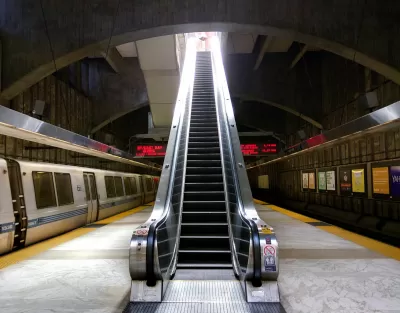Introduced during the pandemic in an area where many residents now work remotely, the new stations have failed to attract new commuters.

Bay Area Rapid Transit (BART), which serves the San Francisco Bay Area, opened two new stations this summer, hoping to draw more commuters to the system with a $2.3 billion extension to Milpitas and Berryessa. To bring BART to the South Bay, VTA, Santa Clara County's transportation authority, agreed to fund the extension and contribute to overall system improvements in exchange for keeping the proceeds from South Bay station fares and parking fees.
With COVID-19 bringing commuting down drastically as many Bay Area workers stay home, ridership to and from the new stations has been disappointing. VTA remains optimistic. "The systems were expanded looking out for 100 years — this is a long, long-term investment," spokesperson Bernize Alaniz told the Mercury News. With thousands of new apartment units going up around the South Bay stations, the agency expects a large influx of new BART riders in the coming months and years. Those who have used the new stations had positive reviews, citing them as "some of the nicest" they'd seen. And while many people can work from home during the pandemic, many essential workers still rely on public transit. Despite low current ridership, now is not the time to make cuts to essential transit services that serve the most vulnerable communities.

Planetizen Federal Action Tracker
A weekly monitor of how Trump’s orders and actions are impacting planners and planning in America.

Maui's Vacation Rental Debate Turns Ugly
Verbal attacks, misinformation campaigns and fistfights plague a high-stakes debate to convert thousands of vacation rentals into long-term housing.

San Francisco Suspends Traffic Calming Amidst Record Deaths
Citing “a challenging fiscal landscape,” the city will cease the program on the heels of 42 traffic deaths, including 24 pedestrians.

Defunct Pittsburgh Power Plant to Become Residential Tower
A decommissioned steam heat plant will be redeveloped into almost 100 affordable housing units.

Trump Prompts Restructuring of Transportation Research Board in “Unprecedented Overreach”
The TRB has eliminated more than half of its committees including those focused on climate, equity, and cities.

Amtrak Rolls Out New Orleans to Alabama “Mardi Gras” Train
The new service will operate morning and evening departures between Mobile and New Orleans.
Urban Design for Planners 1: Software Tools
This six-course series explores essential urban design concepts using open source software and equips planners with the tools they need to participate fully in the urban design process.
Planning for Universal Design
Learn the tools for implementing Universal Design in planning regulations.
Heyer Gruel & Associates PA
JM Goldson LLC
Custer County Colorado
City of Camden Redevelopment Agency
City of Astoria
Transportation Research & Education Center (TREC) at Portland State University
Jefferson Parish Government
Camden Redevelopment Agency
City of Claremont





























